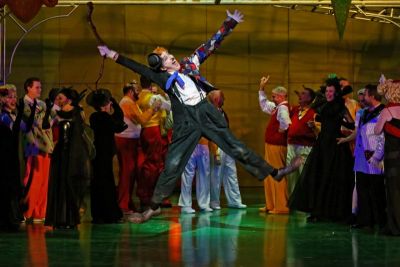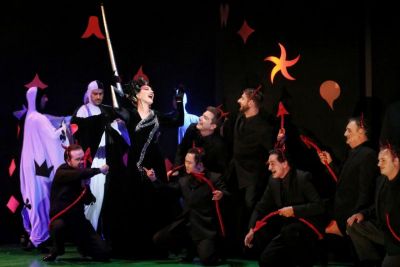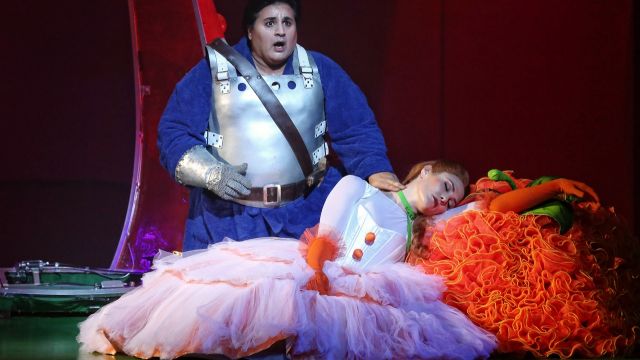The Love for Three Oranges
This strange combination of commedia dell’arte and opera lends itself to all sorts of imaginative design and action, and this production, first performed in 2005, has all the hallmarks of twenty-first century technical creativity. It is bright and whimsical, with all the zaniness and pace of true comic farce depicted in music that pops and bubbles like a bottle of fizz.
George Tsypin’s set is populated by huge, colourful, pulsing props, tubular steel, flashing lights and even a few moments of fizzing fireworks. Human cacti depict the desert and an enormous inflated body hangs over the stage.
Tanya Noginova’s costumes, obviously prudently stored and carefully restored, are similarly bizarre. The chorus vibrantly depicts the theatrical genres of tragedy, romantic comedy, lyric drama and farce. The major roles are depicted as the stock characters of commedia and melodrama, and their costumes accentuate the good, the evil and the comic nature of each character. Tsypin and Noginova’s combined their artistic imaginations to create the oranges – immense luminous shapes that dominate the stage and open to reveal lacy orange trees.

There is little subtlety in the mixture of textures, rhythms and melodies that Prokofiev used to transform a rather silly eighteenth century Italian commedia scenario written by Carlo Gozzi into an opera that would entertain a New York audience in 1921. The music is as flighty as the capricious characters of the fantasy that revolves around an unhappy prince, a card game, a curse that compels the prince to love three oranges, which, when he finds them turn into three thirsty princesses, two of whom die. The prince falls in love with the third, who is turned into a rat. Fortunately the chorus diverts the imploding plot to a happy ending.
Revival director, Matthew Barclay has been true to the inspired ‘whackiness’ of Francesca Zambello’s original production. Pratfalls and slapstick mix fairly happily with melodrama and romance. There are no long arias or indeed any tragic operatic deaths. The action is as epigrammatic as the music: witty, rhythmic, engaging … and just a bit over-the-top.
The whole cast seems to enjoy the chance to be a bit silly rather than dramatically restrained. David Parkin in white and silver hobbles crookedly as the ageing King of Clubs, Gennadi Dubinsky the King’s wizard, Chelio. Rosario La Spina is the melancholy Prince, Eva Kong, Catherine Bouchier and Julie Lea Goodwin the three orange princesses.

Margaret Trubiano and Andrew Moran play the scheming niece and Prime Minister who plot to take over the throne with the help of the wicked Fata Morgana played with by villainous aplomb by Antoinette Halloran.
Kanen Breen comes into his own in this production as Truffaldino, leading the performers and the audience them through the various silly twists and ridiculous turns of the plot. He is lithe, energetic, acrobatic and totally engaging.
This is not an opera for purists – but it’s fun and theatrical and colourful and entertaining.
Carol Wimmer
Images: (from top) Rosario La Spina (The Prince) and Catherine Bouchier (Princess Nicoletta), Kanen Breen (Truffaldino), and Antoinette Halloran (Fata Morgana) in Opera Australia's production of The Love for Three Oranges. Photographer: Prudence Upton.
Subscribe to our E-Newsletter, buy our latest print edition or find a Performing Arts book at Book Nook.

